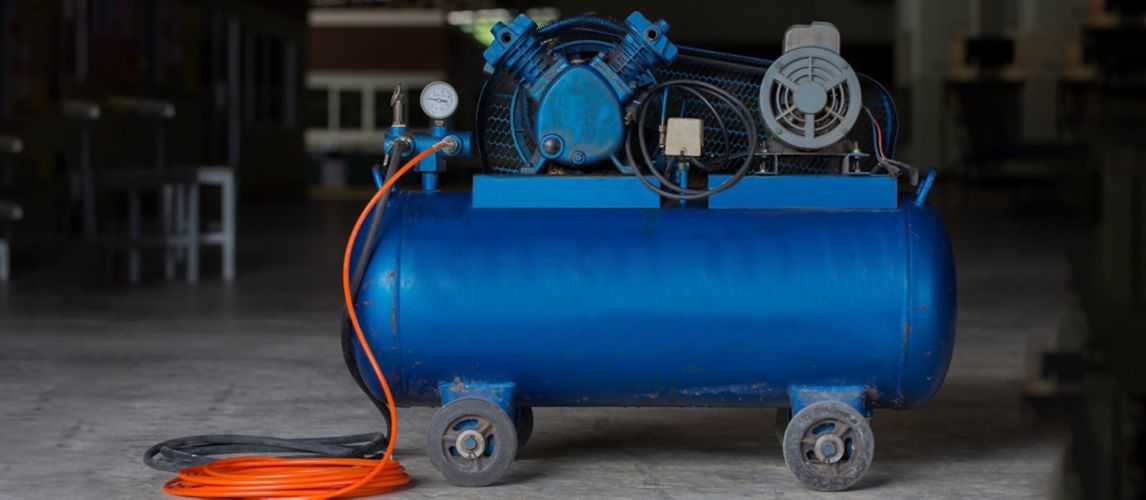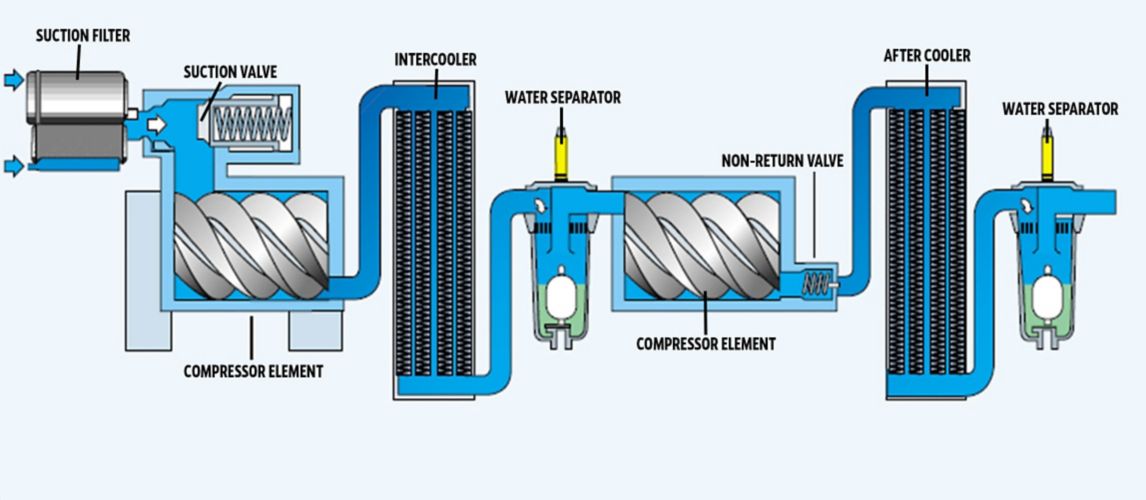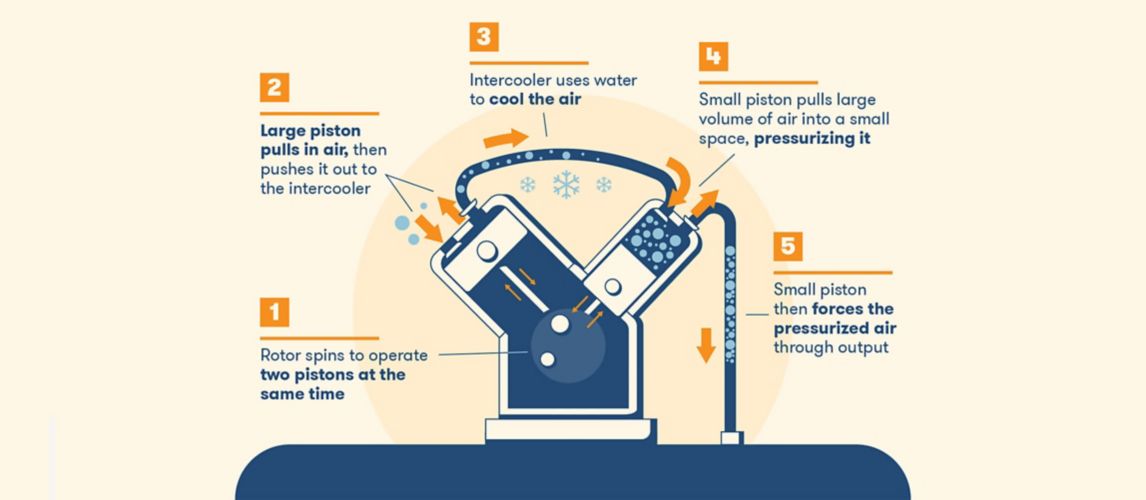Air compressor buying guide
Air compressor buying guide
Introduction
We know that choosing an air compressor can be a daunting task. There are so many to choose from, and the technical terminology can be confusing if you don’t know what to look out for. So how do you choose the right air compressor for your needs?
This comprehensive air compressor buying guide will help. It covers how air compressors work, their uses and their features. It explains what CFM requirements are and looks at the different air compressor fitting types. It lists what size air compressors are required for different jobs and highlights some key things to consider when buying an air compressor. Finally, it answers some frequently asked questions. You can view our range of air compressors here.

How Does an Air Compressor Work?
An air compressor is a machine that converts atmospheric air into energy that’s then used to power a variety of tools and devices. Its main components are a motor, pump and air storage tank.
An air compressor works by sucking in air through the pump, which then forces it into the storage tank, compressing it as it goes. Once the tank reaches capacity, the air compressor shuts off. The stored compressed air can then be used as power by attaching an air hose and air tool to the tank. When the trigger on the tool is pressed, pressurised air is released to power the tool.
- Belt drive vs direct drive air compressor
Belt drive air compressors have a belt that connects the pump to the motor, which turns when the motor is running. The size of the belt determines the pressure and speed the air compressor can reach. The main advantage of belt-drive air compressors is that the pressure and speed can be varied by adjusting or changing the belt, making them more flexible in terms of the tools they can power. They are also quieter than direct drive air compressors and require less maintenance, although the tension in the belt does have to be constantly monitored. This type of air compressor comes with a large storage tank and is designed for heavy-duty workshop and industrial use.
Direct drive air compressors are simpler in design, with their pump connected directly to the motor. They are more energy-efficient and reliable than belt drive models, but they are noisier and more expensive to buy. This type of air compressor has a small tank and is designed for home and semi-professional use. - What is a magnetic starter on an air compressor?
A magnetic starter is an electromagnetically operated switch that’s typically found on powerful air compressors (5HP or above). It’s a safety device that stops electricity from powering the motor if it detects an overload, preventing the main pressure switch from burning out. Powerful air compressors without this device may frequently need their main pressure switch to be replaced. - What is a reed valve air compressor?
A reed valve air compressor has a valve located in the pump called a reed valve. It’s there to ensure that airflow only goes in one direction. A faulty reed valve results in loss of power and air pressure build-up. - What is a tandem type air compressor?
A tandem type air compressor is also known as a two-stage air compressor. This is because it compresses the air twice, rather than once, for double the pressure. It’s best used for heavy-duty industrial work where frequent and prolonged use is required. - How does an oil-less air compressor work?
All air compressors require lubrication to their moving parts to moderate heat, friction and wear and tear. An oiled air compressor uses oil as lubrication, while an oil-less air compressor doesn’t. Instead, the parts are coated in a friction-reducing, self-lubricating chemical.
Oil-less air compressors are lighter, quieter and require less maintenance than oiled models. And their biggest benefit is that the lack of oil means no contaminants are transferred into the pressurised air. For this reason, they are ideal for spray painting and in clinical settings.
On the other hand, Oiled air compressors require less maintenance, but the oil contaminates the air. They are best used for professional, heavy-duty work where prolonged use is required.

How to Choose an Air Compressor
The most important factor to consider when choosing an air compressor is what tools and tasks you will use it for. That will then determine the CFM (cubic feet per minute) requirement to power the tools (see more detail in the next section).
You’ll also need to consider how frequently and how long you’ll use it to determine what air storage tank capacity you need. For example, you’ll only need a small tank for occasional DIY use, but a large tank will be better for professional or prolonged use.
Other considerations include whether it needs to be portable, and therefore whether you need a corded or cordless model, and if you need a brushed or brushless motor or an oiled or oil-less model.
- Corded or cordless?
Corded air compressors are plugged into the electricity to supply power to the motor, which means they must be used near a power socket. For this reason, corded air compressors are best suited for use in factories and workshops where portability isn’t required.
On the other hand, cordless air compressors are powered by petrol or diesel. The absence of a cord means they can be used anywhere and are much easier to move around. - Brushed or brushless?
Brushed air compressors have a motor that’s driven by small metal brushes. Whereas brushless air compressors have a motor with an electronic circuit board and sensor. The absence of brushes on a brushless motor means reduced friction and heat build-up and, therefore, less wear and tear, which gives them a long lifespan. Brushless motors are also more efficient to run than brushed motors. - Oiled or oil-less?
As explained in the section above, an oiled air compressor has moving parts that are lubricated by oil. In contrast, an oil-less air compressor’s components have a special self-lubricating coating. Choosing between the types can be decided by considering how much the air compressor will be used and whether non-contamination of the air is important. For example, if the air compressor will be used for long hours daily in a factory, an oiled model will be best. Whereas an oil-less model is better for infrequent or DIY use. And if the air compressor will be used for spray painting or in a clinical setting, an oil-less model will supply non-contaminated air. - Tank capacity
Air compressors come in various tank sizes, measured in litres, ranging from 4L to 100L. Generally, the larger the tank, the longer you can run the air compressor at a consistent power. However, the tank size you need will also depend on the tool you plan to use it with. All tools require a minimum airflow, measured in cubic feet per minute (CFM). To determine what tank capacity you need for a tool, multiply the tool’s standard cubic feet per minute (SCFM) by 6.
CFM Requirements Explained
CFM stands for cubic feet per minute, and it relates to the rate of airflow an air compressor can deliver. All air tools are given a standard cubic feet per minute (SCFM) rating, indicating the minimum amount of airflow they require to run.
To calculate the CFM of the air compressor you need, simply multiply the air tool’s SCFM (which can be found in the manufacturer’s manual or website) by 1.2. So, for example, for an air tool with 6 SCFM, you’ll need an air compressor with at least 7.2 CFM (6 x 1.2 = 7.2).
The table below lists the average CFM required for some popular air tools. But always check the exact requirement for your tool:
|
Air tool type |
Tool SCFM |
Required air compressor: minimum CFM |
|---|---|---|
|
Nail gun |
1 |
1.2 |
|
½“ Impact wrench |
5 |
6 |
|
¾” Impact wrench |
7 |
8.4 |
|
Spray gun |
6 – 18 |
7.2 – 21.6 |
|
Die grinder |
8 |
9.6 |
|
Air drill |
4 |
4.8 |
|
Orbital sander |
6 |
7.2 |
|
Angle grinder |
6 |
7.2 |
|
Grease gun |
4 |
4.8 |
|
¼” Ratchet |
3 |
3.6 |
|
3/8” Ratchet |
4 |
4.8 |
|
Hammer |
4 |
4.8 |
|
Sandblaster |
4 |
4.8 |
Air Compressor Uses
Air compressors can be used for various tasks around homes, garages, workshops and building sites. Here are some of their most popular uses:
-
Inflating: when used with an inflating gun, air compressors can be used for pumping up a car, bike and wheelbarrow tyres.
-
Spray painting: when used with a spray-painting gun, an air compressor can be used to spray paint on cars, walls, furniture, etc. They are excellent at spraying greater volumes of paint than other paint sprayers.
-
Pressure washing: an air compressor can be used as a pressure washer by using a pressure washer attachment connecting the air hose and a garden hose.
-
Air tools: there are a large variety of air tools available, such as nail guns, drills, hammers, ratchets, wrenches, etc., that allow you to carry out a multitude of home improvement and building tasks. Air tools are often favoured over equivalent corded or battery-powered tools because they are lighter and smaller. In addition, they are safer to use in certain areas where an electric tool could pose a risk, i.e., in damp areas or where there are combustible gases.
Air Compressor Fitting Types
Air compressor fittings are important components of air compressors. You must use the correct ones to ensure the safe and efficient operation of the air tools used. This section of the air compressor buying guide lists the different types of air compressor connectors and fittings available.
- Air hose fitting
On an air compressor, one end of the air hose is fitted to the tank, and the other end is fitted to an air tool. Each end of the hose will come with an air hose fitting which will be either a thread fixing or a quick release coupling (see below for more detail on these). Any connectors you fit to the hose will need to be compatible. - BSPF and BSPM
The BSP part of these acronyms stands for British Standard Pipe, and it refers to the standard screw thread types used internationally for connecting and sealing pipe ends. The F stands for female, and the M stands for male, and to connect two fittings, you need a male and female end. - Quick-release couplings
Quick-release couplings are a type of fitting that allows you to connect and disconnect airlines from each other quickly and easily. They also have male and female parts which must be coupled together. Quick-release couplings are designed to seal off the airflow when disconnected via an O-ring, eliminating the need for a shut-off valve. - PCL couplings
PCL couplings are a type of fitting that can be disconnected by pulling back a collar whilst holding the connected tool. When disconnecting these couplings, you need to take care as the air hose can whip about as the air escapes. For this reason, these couplings are best used where they will be fixed in place, such as on the end of the air hose that's directly attached to the compressor. - Hose tail
A hose tail fitting can connect couplings to hoses or connect two hoses together. It’s important to ensure the hose tail matches the diameter of the hose it will be connected to and that it’s secured using a jubilee clip.
What Size Air Compressor for Different Jobs?
When referring to air compressor size, we refer to the airflow rate it can deliver, measured in cubic feet per minute (CFM). The rate you need will depend on the task you are carrying out and your tools.
This section of the air compressor selection guide covers some of the most common uses for an air compressor and recommends the size of air compressor you need for the task. However, you should always check the manufacturer's instructions for your tools for exact compatible air compressor sizes.
- What size air compressor for the garage?
You will likely use a range of tools in a garage, so you should choose an air compressor size suited to the tool that needs the highest SCFM rate to work. For example, paint spray guns usually have the highest CFM requirements, needing an air compressor that delivers around 22 CFM. - What size air compressor do I need for a plasma cutter?
For most plasma cutters, you'll need an air compressor with a minimum of 6 CFM. - What size air compressor for framing nailer?
Most framing nailers need an air compressor with a minimum of 2.4 CFM. - What size air compressor for nail guns?
Most nail guns need an air compressor with a minimum of 1.2 CFM. - What size air compressor is needed for spray painting?
Spray gun CFM requirements vary greatly. Depending on your type, you'll need an air compressor with a minimum CFM of between 7.2 and 21.6.
Air Compressor Features Explained
There are a few different features to look out for when buying an air compressor. In this section, we list the features and explain what they are.
- Working pressure
Working pressure is a measurement of the amount of pressure generated inside the tank of an air compressor, measured in bar and pounds per square inch (PSI). Most compressors are 8 bar/115 PSI. - Petrol/diesel or electric
Air compressors can run on petrol/diesel or electric. Electric air compressors need to be plugged into an electricity supply, so they tend to be used in factories and workshops where they stay in one place. However, petrol/diesel air compressors can be moved around, making them more suited to trades such as mobile mechanics. - Motor power
The motor power of an air compressor is measured in horsepower (HP). Generally, the more horsepower the motor has, the quicker it can build up pressurised air and keep the airflow rate constant. - Piston displacement and free air delivery
Piston displacement is the volume of air produced by the pump, while free air delivery (FAD) is the actual volume the air compressor will produce (both measured in CFM). FAD is usually 25-30% lower than piston displacement. When buying an air compressor, the CFM stated is often the piston displacement measurement, so you'll need to take the 25-30% drop in airflow into account to ensure you get an air compressor with the right CFM for your tools.

Key Considerations When Buying an Air Compressor
Here are a few more things to consider before buying an air compressor:
-
What tank capacity do you need?
Air compressors come in a variety of tank sizes, measured in litres. Generally, the larger the tank, the longer you can run the air compressor before it needs to refill itself. The tank size you need will depend on how much airflow the tool needs (see the section on CFM requirements above) and whether that airflow is delivered in short bursts or a constant stream. For example, a nail gun will only use short bursts of airflow, while a sander needs continuous airflow at a high level. -
What power do you need?
When it comes to power on an air compressor, the best measurement to look at is the airflow rate, measured in cubic feet per minute (CFM). You'll need a machine with a high enough airflow rate to power the tools you plan to use with it. To work out what you need, check the tool's SCFM and multiply it by 1.2. That will give you the minimum CFM needed. If the SCFM of the tool isn't stated as 'free air delivery', then add 25-30% onto the calculation. - What about air compressor safety and maintenance?
Air compressors deliver powerful bursts of air which can cause injury to the skin, so you must wear suitable protective clothing, including gloves and goggles, while using one. And the hose and tools should be depressurised before disconnecting them from the machine. It's also essential that you use the right amount of pressure for the tool you are using. Never use more pressure than the tool can take. Finally, never use extension leads with an air compressor; this can lead to overheating and fires.
When it comes to maintenance, there are several things you need to do to keep the machine in good working order:
- Check and clean out the air vents (related to the cooling system) regularly to ensure they aren’t blocked to avoid overheating.
- Regularly clean the air intake filter, and replace it when it is worn out.
- Regularly drain off condensate and moisture from the air storage tank (release the compressed air before doing this).
- Check hoses and fittings for wear and tear and replace them when necessary.
- Check and change the cooling and engine oil (if it’s a diesel/petrol air compressor or one that uses oil for the cooling system).
- Check the drive belt (in belt drive air compressors) and replace it when it’s worn out.
- Lubricate the moving parts of the air compressor and any tools.
